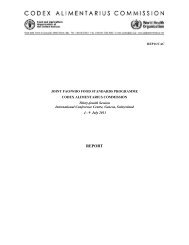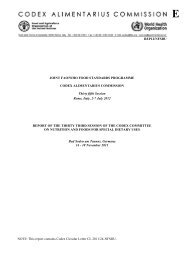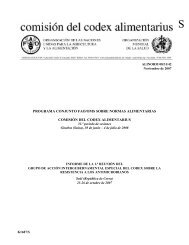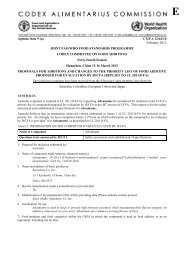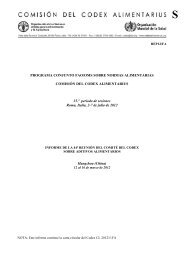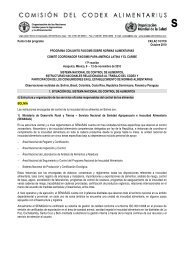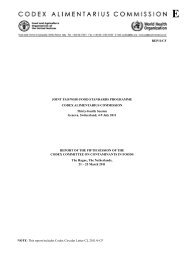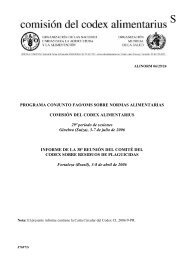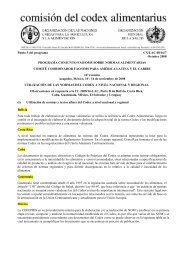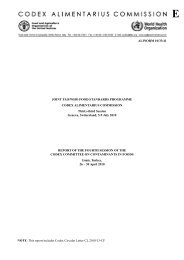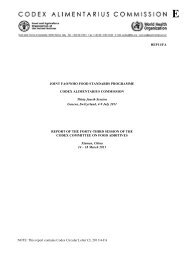JOINT FAO/WHO FOOD STANDARDS PROGRAMME ... - Cclac.org
JOINT FAO/WHO FOOD STANDARDS PROGRAMME ... - Cclac.org
JOINT FAO/WHO FOOD STANDARDS PROGRAMME ... - Cclac.org
Create successful ePaper yourself
Turn your PDF publications into a flip-book with our unique Google optimized e-Paper software.
ALINORM 07/30/24 Page 23JMPR would consider the concerns at a future meeting and the CCPR would subsequently decide on thestatus of the MRL.221. The Committee noted that future JMPR reports would contain a special section including allrequests received and provide answers where possible. The section would also identify those concerns to beaddressed at subsequent meetings or for which no forms had been submitted.222. Some delegations expressed the view that if the concern forms were not submitted in time, theproposed MRLs would be advanced to Step 8 at the following session of the CCPR. The Codex Secretariatadvised that whether the MRL was forwarded to Step 8 would depend on the consensus reached in theCommittee.Availability of JMPR reports223. The JMPR Secretariat recalled that an important condition for using the procedure to advanceproposed draft MRL to Steps 5/8 was the publication of the JMPR report by early February and suggestedthe following deadlines to ensure that the report would be available in time:a) The Data Directory for residue data of the compound should be available by 1 September (starting in2008 for the 2009 JMPR), i.e., the Residue Data Directory will be made available one year in advance ofJMPR;b) The full submission of all residue data is required by 30 November (starting in 2010 for the 2011JMPR);c) It was also noted JMPR would also welcome submissions earlier than the above deadlines.224. The Committee agreed with these proposals in order to ensure timely availability of the JMPRreport and to facilitate consideration of MRLs in the Committee.Consideration of Alternative GAPs225. The Committee noted that this issue was related to the document prepared by the United Stateswhich was considered under Agenda Item 4(a) 23 . Both items were discussed together.226. The JMPR Secretariat recalled that the JMPR had identified two approaches to recommending anMRL relating to the highest residues from a national GAP: the retrospective approach to consider analternative GAP when requested to do so by CCPR, and the prospective approach to consider an alternativeGAP when the IESTI exceeds the ARfD. The 38 th Session of the CCPR had agreed that the retrospectiveapproach was mainly applicable for old compounds, and that the prospective approach would become theroutine approach. On the basis of the experience gained with these approaches at the 2006 JMPR, the JMPRSecretariat proposed that, in future, requests for retrospective GAPs be removed from the agenda of JMPR ifno updated information was submitted (including information on current GAP which is always needed) andno support for such an evaluation was provided by sponsors or Codex Members at a session of the CCPR.227. The Committee agreed with the approach proposed by JMPR. The Committee noted that thequestion of alternative GAPs would be reconsidered at the next session when JMPR comments on documentCX/PR 07/39/2-Add.1 presented under Agenda Item 4 (a) would be available. The Committee also agreedthat there might be a need to revise the Risk Analysis Principles applied by the CCPR in the future to includethe alternative GAP procedure.UPDATE OF EC LEGISLATION228. The Delegation of the EC informed the Committee that currently approximately 50% of thepesticide MRLs were harmonized in the EC while the remaining MRLs were set at the national level andmight differ from country to country, and that the legislation on pesticide MRLs was expected to becompletely harmonized following publication of the new Regulation 396/2005. One of the 4 annexes in theRegulations relates to MRLs that were not previously harmonized. The Committee was informed thatfinalisation of this list was currently the priority within the European Commission, the Member States andthe EFSA and the work it is likely to be completed in 2007. The Delegation explained that the developmentof this annex has involved the collection of all member state MRLs and Codex MRLs in order to selectcandidate EU MRLs. EFSA opinions on these candidate MRLs are available on the EFSA website. Furtherwork on these MRLs is ongoing in the EFSA, the Commission and the Member States on the basis of23 CX/PR 07/39/2-Add.1



